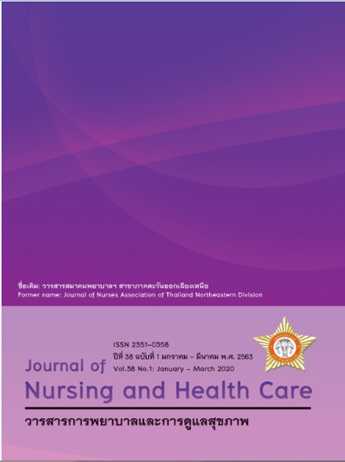ผลของการใช้โปรแกรมการพยาบาลระยะ 1 ชั่วโมงแรกต่อผลลัพธ์ที่คัดสรรในผู้ป่วย Sepsis และ Septic shock ที่แผนกงานฉุกเฉิน
คำสำคัญ:
โปรแกรมการพยาบาลระยะ 1 ชั่วโมงแรก, Sepsis, Septic shock, อวัยวะทำงานผิดปกติบทคัดย่อ
การวิจัยแบบกึ่งทดลองนี้มีวัตถุประสงค์เพื่อศึกษาผลของการปฏิบัติการพยาบาลตามโปรแกรมการพยาบาลผู้ป่วย sepsis และ septic shock ในระยะ 1 ชั่วโมงแรก ในผู้ป่วยที่มีภาวะSepsis และSeptic shock ที่เข้ารับการรักษาในแผนกงานอุบัติเหตุฉุกเฉินโรงพยาบาลสมเด็จพระยุพราชธาตุพนมจำนวน 94 คน แบ่งเป็นกลุ่มเปรียบเทียบจำนวน 47 คนซึ่งได้รับการดูแลตามแนวทางปกติของโรงพยาบาล และกลุ่มทดลองจำนวน 47 คนที่ได้รับการดูแลตามโปรแกรมการพยาบาลฯ ประเมินผลลัพธ์ 2 ด้านคือ ด้านผู้ป่วยและด้านพยาบาล วิเคราะห์ข้อมูลโดยใช้สถิติ t-test, chi-squared, Relative risk, ความถี่ ร้อยละ ค่าเฉลี่ย และส่วนเบี่ยงเบนมาตรฐาน
ผลการศึกษาด้านผู้ป่วยพบว่ากลุ่มเปรียบเทียบเกิดภาวะ Organ dysfunction 30 คน คิดเป็นอุบัติการณ์การเกิด 63.83 คน/1000ประชากร (95%CI: 51.47-79.12)ในขณะที่กลุ่มทดลองเกิด 9 คนคิดเป็นอุบัติการณ์การเกิด 19.14 คน/1000ประชากร (95%CI: 10.64-34.45) ผู้ป่วยกลุ่มเปรียบเทียบมีโอกาสเสี่ยงในการเกิดภาวะ Organ dysfunction ภายใน 6 ชั่วโมงมากเป็น 3.33 เท่า (RR=3.33, 95%CI=1.78-6.23, p=.0002) ของผู้ป่วยกลุ่มทดลอง ผลด้านพยาบาลพบว่าพยาบาลมีวินัยในการปฏิบัติตามกิจกรรมของโปรแกรมการพยาบาลฯ โดยรวมร้อยละ 90.21 และมีสัดส่วนการปฏิบัติกิจกรรมการพยาบาลในกลุ่มทดลองมากกว่ากลุ่มเปรียบเทียบ นอกจากนี้ พยาบาลในกลุ่มทดลองใช้เวลาในการเริ่มให้การพยาบาลน้อยกว่ากลุ่มเปรียบเทียบในทุกกิจกรรม ดังนั้นจึงสรุปได้ว่าการปฏิบัติใช้โปรแกรมการพยาบาลผู้ป่วย sepsis และseptic shock ในระยะ 1 ชั่วโมงแรก ช่วยลดการเกิดอุบัติการณ์ ความเสี่ยง และความรุนแรงของอาการของผู้ป่วย sepsis และ septic shock ลงได้ และยังเพิ่มความมีวินัยและสัดส่วนของการปฏิบัติกิจกรรมพยาบาล พร้อมทั้งช่วยลดระยะเวลาในการเริ่มให้การพยาบาลลงได้
Downloads
เอกสารอ้างอิง
2. Mehta Y, Kochhar G. Sepsis and Septic Shock. Journal of Cardiac Critical Care TSS 2017; 1(1): 3-5.
3. World health Organization. Improving the prevention, diagnosis and clinical management of sepsis. 2017.
4. Fleischmann C, Scherag A, Adhikari NK, Hartog CS, Tsaganos T, Schlattmann. Assessment of global incidence and mortality of hospital-treated sepsis current estimates and limitations. American Journal of Respiratory and Critical Care Medicine 2016; 193(3): 259–272.
5. สำนักนโยบายและยุทธศาสตร์.สถิติสาธารณสุข พ.ศ. 2558: Public Health Statistis 2015.กรุงเทพฯ: โรงพิมพ์องค์การสงเคราะห์ทหารผ่านศึก; 2559.
6. Gotts EJ, Matthay AM. Sepsis: pathophysiology and clinical management. British Medical Journal 2016
7. Bloos F, Thomas-Ruddel D, Ruddel H, Engel C, Schwarzkopf D, John CM. Impact of compliance with infection management guidelines on outcome in patients with severe sepsis: a prospective observational multi-center study. Critical Care 2014; 18(2): R42.
8. Dellinger RP, Levy MM, Rhodes A, Annane D, Gerlach H, Opal SM. Surviving Sepsis Campaign: International Guidelines for Management of Severe Sepsis and Septic Shock: 2012. Crit Care Med 2013; 41:580-637.
9. Finkelsztein EJ, Jones DS, Ma KC, Pabón MA, Delgado T. Nakahira K. Comparison of qSOFA and SIRS for predicting adverse outcomes of patients with suspicion of sepsis outside the intensive care unit. Critical Care 2017; 21(1): 73.
10. Singer M, Deutschman CS, Seymour CW, Shankar-Hari M, Annane D. Bauer M, et al. The third international consensus definitions for sepsis and septic shock (Sepsis-3). JAMA 2016; 315(8): 801–10.
11. Levy MM, Evans LE, Rhodes A. The surviving sepsis campaign bundle: 2018 update. Intensive Care Med 2018; 44:925-928
12. โรงพยาบาลนครพนม. เอกสารโครงการพัฒนาระบริการสาขาโรคติดเชื้อ (Service plan sepsis).โรงพยาบาลนครพนม เครือข่ายเขตสุขภาพที่8 (ไม่ได้ตีพิมพ์). 2560
13. ปฏิพร บุณยพัฒน์กุล. ประสิทธิผลของระบบการบริการสุขภาพฉุกเฉินต่ออาการทางคลินิกในผู้ป่วยที่มีภาวะพิษเหตุติดเชื้อ.(วิทยานิพนธ์) คณะแพทยศาสตร์โรงพยาบาลรามาธิบดี มหาวิทยาลัยมหิดล; 2558
14. Andaluz D, Ferrer R. SIRS, qSOFA, and organ failure for assessing sepsis at the emergency department. Journal of Thoracic Disease 2017; 9(6): 1459-1462.
15. Geoffrey EH, Rachel ET, Rachel S, Joseph DL, Aaron MB, Andrew JS. et.al. Triage sepsis alert and sepsis protocol lower times to fluids and antibiotics in the ED. American Journal of Emergency Medicine 2016; 34(2016): 1-9.
16. Ho KM, Lan, NS. Combining quick Sequential Organ Failure Assessment with plasma lactate concentration is comparable to standard Sequential Organ Failure Assessment score in predicting mortality of patients with and without suspected infection. Journal of Critical Care 2017; 38(2017): 1–5.
17. เพ็ญศรี อุ่นสวัสดิพงษ์, กรองกาญจน์ สังกาศ, ศศิมา กุสุมา ณ อยุธยาและยงค์ รงค์รุ่งเรือง. ผลของกิจกรรมพยาบาลมุ่งเป้าในระยะ 6 ชั่วโมงแรกต่อความรุนแรงของอวัยวะล้มเหลวในผู้ป่วยที่มีกลุ่มอาการ sepsis. Journal of Nursing Science 2554; 29(2): 102-110.
18. Elizabeth NR, Karen LT, James AR. Barriers to clinical practice guideline implementation for sepsis patients in the emergency department. Journal of Emergency Nursing 2018); 44(6): 552-556.
19. Elizabeth RT, Kimberly W, Melanie H, Brenda SB, Kimberly S. Interprofessional collaboration to improve sepsis care and survival within a tertiary care emergency department. Journal of emergency nursing 2017; 43(6): 532-538.
20. Damiani E, Donati A, Serafini G, Rinaldi L, Adrario E, Pelaia P.et.at. Effect of performance improvement programs on compliance with sepsis bundles and mortality: A systematic review and meta-analysis of observational studies. PLoS ONE 2015; 10(5): 1–24.
21. วิไลวรรณ เนื่อง ณ สุวรรณ, จิราพร น้อมกุศล, รัตนา ทองแจ่ม, ธนชัย พนาพุฒิ. การพัฒนาระบบการพยาบาลผู้ป่วยที่มีภาวะติดเชื้อในกระแสเลือดอย่างรุนแรง.วารสารการพยาบาลและการดูแลสุขภาพ 2557; 32(2): 25-36.
22. Elizabeth W. Raising awareness for sepsis, septic screening, early recognition, and treatment in the emergency department. Journal of emergency nursing 2018; 44(3): 224-22



